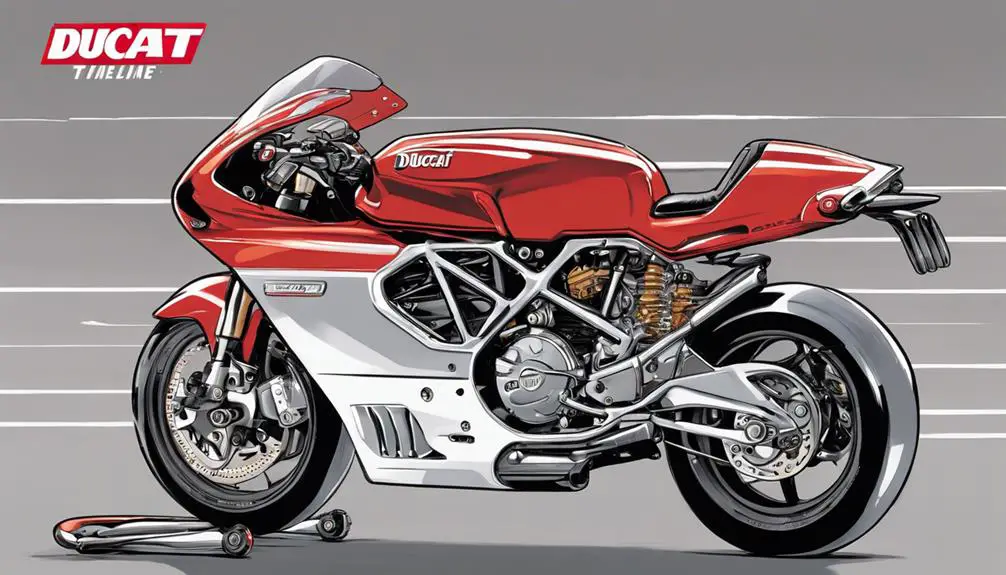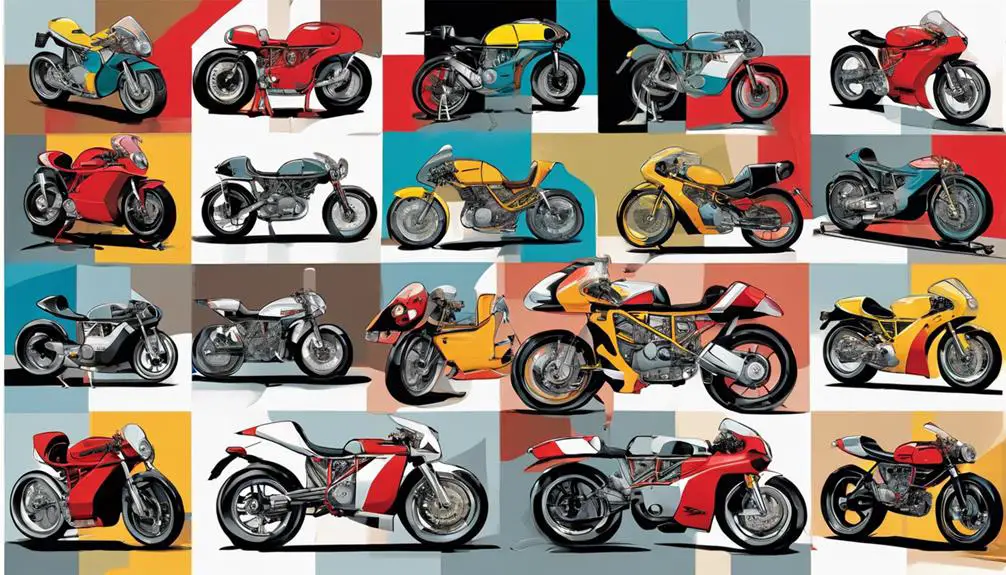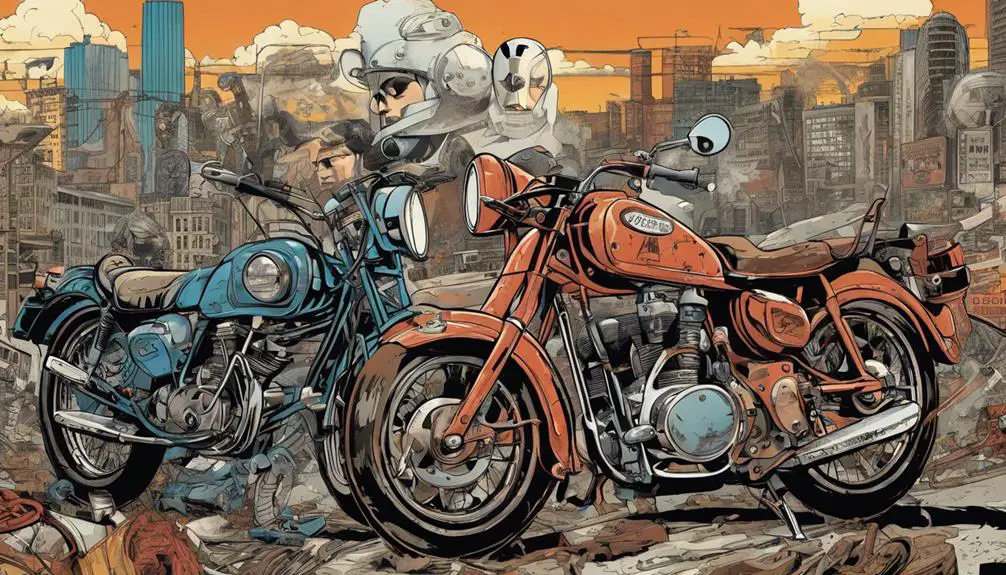Just as the legendary phoenix rises from its ashes, motorcycle specifications have transformed dramatically over the years. You might find it intriguing how advancements in engine technology and suspension systems have shifted the riding experience. There's a wealth of knowledge about design innovations and regulatory impacts that can deepen your understanding of modern bikes. However, what about the common issues lurking in older models that could affect your choice? Let's explore these facets to uncover how past changes shape today's riding landscape.
Key Takeaways
- Understand the evolution of engine types, such as the shift from L-twin to V4 engines for improved performance.
- Familiarize yourself with advancements in suspension technology, including electronic systems that enhance ride stability.
- Keep abreast of design innovations, like lightweight materials and ergonomic features that improve handling and comfort.
- Stay informed about emission standards and their impact on engine efficiency and environmental performance.
Evolution of Ducati Engine Specs

Ducati's engine specifications have evolved considerably over the years, reflecting advancements in technology and performance. You can feel the spirit of liberation with every rev of a Ducati, as its engines have transformed from basic designs to powerful marvels of engineering.
Initially, you might've experienced the classic L-twin engines, which provided a unique character and sound. Now, you're riding bikes equipped with advanced Desmodromic valve systems and cutting-edge electronics.
As you explore the latest models, you'll notice the introduction of high-performance V4 engines, delivering unparalleled power and torque. These advancements not only enhance speed but also improve handling and responsiveness, fueling your desire for freedom on the open road.
The integration of lightweight materials and sophisticated fuel injection systems means each ride is more exhilarating and efficient.
You've got options, too—whether you're drawn to the raw power of a Panigale or the sporty feel of a Monster, Ducati's evolution caters to your thirst for adventure.
With every twist of the throttle, you're not just riding; you're embracing a legacy that champions performance and liberates the spirit. So gear up and experience the thrill that only Ducati can offer.
Changes in Suspension Technology
As you embrace the thrill of Ducati's powerful engines, you'll also appreciate the significant advancements in suspension technology that enhance your ride's comfort and control. Modern suspension systems, like the fully adjustable forks and rear shocks, give you the freedom to fine-tune your motorcycle for any terrain. You can dial in compression and rebound settings to match your riding style and the road ahead, allowing for a personalized experience.
Gone are the days of stiff, unforgiving setups. Today's suspension systems utilize advanced materials and engineering, such as lightweight aluminum and high-performance damping fluids, to provide a smooth ride without compromising responsiveness. You'll feel the difference as you carve through corners or glide over bumpy roads, maintaining confidence and stability.
Moreover, electronic suspension systems, like Ducati's Skyhook, automatically adjust to changing road conditions, freeing you from constant manual adjustments. This technology reacts in real-time, ensuring your ride remains balanced and controlled, no matter the environment.
Embrace these innovations, and let your Ducati carry you to new heights of freedom, enhancing both your ride and your connection to the open road.
Advancements in Ducati Design

How have recent advancements in design transformed the aesthetics and functionality of Ducati motorcycles? You'll notice that these changes go beyond just looks; they enhance your riding experience.
With every model, Ducati embraces lightweight materials like carbon fiber and aluminum, reducing weight while maintaining strength. This makes your ride feel more agile and responsive, empowering you to conquer the open road.
The sharp, aggressive lines of Ducati's latest designs not only turn heads but also improve aerodynamics. Improved airflow means you can push the limits without battling resistance, giving you that exhilarating sense of freedom.
Innovations in ergonomics guarantee that you're comfortable and in control, letting you focus on the thrill of the ride rather than discomfort.
Ducati's integration of advanced technology, like TFT displays and ride-by-wire systems, makes your bike more intuitive and customizable. You can tailor your ride to suit your style, whether you're cruising or tearing through corners.
With each advancement, Ducati redefines what it means to ride, blending form and function, and urging you to embrace the liberation that comes from the open road.
Impact of Emission Standards
In recent years, tightening emission standards have greatly influenced motorcycle design, pushing manufacturers to innovate for cleaner, more efficient engines. You might feel the thrill of the open road, but these changes are also about preserving that freedom for future riders.
As regulations become stricter, manufacturers have harnessed technology to produce bikes that maintain their performance while reducing harmful emissions. You'll notice that many new models feature advanced fuel injection systems, lighter materials, and improved combustion processes.
These innovations not only help meet emission targets but also enhance your riding experience. The roar of the engine you love can now come with a conscience, allowing you to explore the world while being mindful of it.
Moreover, these developments often lead to better fuel economy, meaning you can ride longer without worrying about frequent stops at the pump.
Common Problems Over Generations

Motorcycles have faced a range of common problems over generations, from mechanical issues to evolving technology challenges. As a rider, you might've noticed that older models often struggled with reliability. Mechanical failures, like clutch or electrical problems, can turn your ride into a hassle. It's frustrating when you just want to feel that freedom on the open road, but you're stuck fixing your bike instead.
As technology advances, you'll also encounter new issues. For example, modern bikes equipped with complex electronic systems can be hard to troubleshoot. You might find yourself relying on a mechanic more than you'd like, which can feel like a loss of independence.
Another common issue is weight. As manufacturers add safety features and comfort enhancements, bikes tend to get heavier. This can detract from the nimble feel you crave.
Lastly, don't forget about maintenance. As specs change, the types of fluids or parts needed can complicate your upkeep routine. Embracing the spirit of liberation means adapting to these challenges, ensuring that your ride remains a source of joy and freedom through the years.
Frequently Asked Questions
How Do Motorcycle Specifications Affect Resale Value?
Motorcycle specifications can greatly impact resale value.
When you choose models with upgraded engines, advanced technology, or premium features, you boost your bike's appeal to potential buyers. Unique specs often attract enthusiasts willing to pay more.
Conversely, outdated specs might lower interest and price. Keeping your bike well-maintained and documented helps too.
Ultimately, smart choices in specifications can lead to a more lucrative return on your investment when it's time to sell.
What Are the Most Popular Ducati Models Over the Years?
When you think of Ducati, it's like imagining a roaring lion in the motorcycle world.
Over the years, the most popular models have included the iconic Ducati Monster, the sleek Panigale, and the versatile Multistrada.
Each model represents a thrilling blend of power and style, capturing the hearts of riders seeking freedom on two wheels.
If you're dreaming of liberation, these bikes are your ticket to adventure and excitement.
How Can I Identify My Ducati's Model Year?
To identify your Ducati's model year, check the Vehicle Identification Number (VIN) located on the frame. The 10th character of the VIN indicates the model year.
If you're unsure, consult Ducati's official website or contact a local dealer; they can help you decode the VIN.
You might also find clues in your bike's paperwork or service history.
Embrace the journey of discovery and celebrate your ride's unique heritage!
Are There Aftermarket Upgrades for Older Ducati Models?
Absolutely, there are plenty of aftermarket upgrades for older Ducati models!
You can enhance performance with exhaust systems, fuel management tools, and suspension upgrades.
Plus, you'll find custom seats and handlebars that improve comfort and style.
It's all about expressing yourself and making your ride reflect your personality.
Just make sure you research compatibility and quality to keep your Ducati running smoothly while you enjoy the freedom of the open road!
What Is the Typical Lifespan of a Ducati Motorcycle?
Think of a Ducati motorcycle as a finely tuned symphony; with proper care, it can play beautifully for 15 to 20 years.
You'll find that regular maintenance and timely upgrades can extend its life even further.
Riding with passion and keeping an eye on wear and tear lets you enjoy your freedom on two wheels longer.
Embrace the journey, and your Ducati will be a loyal companion for many adventures ahead!
Conclusion
As you journey through the evolving landscape of motorcycle specifications, think of it like riding a winding road. Just as the asphalt shifts beneath your tires, so do the advancements in engines, suspensions, and designs.
For instance, Ducati's move from L-twin to V4 engines mirrors a cyclist upgrading to a lighter bike for better speed.
By staying informed about these changes, you can enhance your ride and keep your passion for motorcycles alive.
Embrace the evolution; it's part of the thrill!